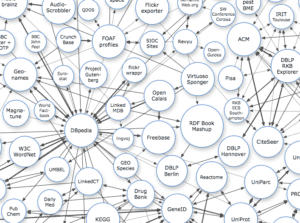Semantic graph databases allow for extreme flexibility in the structuring of your data. While your sources for data may have unchanging schemas, many external data sources are constantly updating their structure. Semantic graph databases use the W3C standard known as Linked Open Data (LOD) to overcome the challenge of sharing data and make it transparent to add public data to corporate applications. The vision for LOD came from Tim Berners-Lee, the inventor of the World Wide Web.
LOD shares both the data and the structure of the data via the W3C standard. So you never have to build or load a schema – semantic graphs are scheme-less because that schema information is built into the data and is passed to AllegroGraph at the time of loading. This feature opens access to literally 10,000’s of data sources that have been made available in the LOD standard which can shorten the time to build an application and enrich the value of that application. These databases include many industry specific databases, like the the National Institute of Health MeSH database for consistent medical vocabulary and SNOMED the international standard for clinical terms. In the last third of this webinar, Taxonomies and Ontologies for Graph Search you can see a demonstration of exactly how sources of public information like these and private data were used to create an application that uncovers high risk patients in the UK health system.
The central clearing house for LOD is called DBpedia which is Wikipedia set into LOD format and contains 2.4 billion pieces of information. Companies like Siemens use LOD for their enhanced CRM database application using AllegroGraph.


